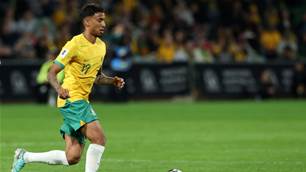The full breakdown of Australia's 2-1 victory over Thailand.
45 shots. 695 completed passes. 75.7% possession. All this statistical dominance, and yet Australia only had two goals to show for it in an astounding display against Thailand. After The War Elephants equalised in the 82nd minute, it looked like Australia were destined to suffer what fans of the popular management simulation Football Manager call ‘getting FM’ed’ – that is, a situation where one team is vastly superior to the other but goes away with an underserved result. However, disaster was averted as Mat Leckie popped up in the box with four minutes to play to ensure Saudi Arabia had to win their match against Japan.

Ange Postecoglou kept the faith in his tactical approach, lining up with the same system in a row for the ninth game on the bounce. However, he did make changes to the personnel operating within it, with Tomi Juric starting ahead of Robbie Kruse at the point of attack, with Tim Cahill filling James Troisi’s spot behind the striker in partnership with Tom Rogic. Alex Gersbach was picked on the left, with Jackson Irvine being removed from the starting eleven, replaced by Milos Degenek. His inclusion meant that the versatile Mark Milligan took up his position on the bottom right of the Australian midfield box. The previously-ill Huddersfield star resumed his place in the team, meaning Massimo Luongo dropped to the bench as a result. Serbian journeyman coach Milovan Rajevac, whose previous role was a two game stint with the national team of Algeria, sent out a team with a clear emphasis on defending in numbers before breaking on the counter. Key to this strategy was
the inclusion of the skilful Supachok Songkrasin, as well as third-highest goal scorer Teerasil Dangda. Including Dangda, of the eleven in the starting line-up, an incredible six are based at Thai champions Muangthong United, whom Hyundai A-League fans may recall Brisbane Roar played earlier this year in the AFC Champions League.
Thailand’s transition from attack to defence
As mentioned previously, Thailand had a clear intent to defend as a unit and then quickly break on the counter. In order to do so effectively however, they needed to ensure a solid defensive platform could give rise to a form in possession which was conducive to a direct, rapid style of football, and did so by a transformation of shape. As a by-product, their approach further highlighted the inaccuracy of pundits when assessing tactical systems, which are generally categorised as simply as 4-3-3, 4-4-2 etc. In actual fact, it is rarely as simple as a couple of context-less numbers. Players positions within a formation are generally only within a few metres of variability independent of what base is used, and it is increasingly seen across the world that football systems are built on the dynamics of play, and the attuning of key principles to various complexities which are apparent in any and every game.

With this in mind, it can be said that Thailand’s shape in possession consisted of two centralised forward players in front of a midfield triangle, located between two wider players (as above). Three centre-backs anchored the team as well as offering safer options to recirculate possession. Once Australia recovered the ball, Thailand retreated into a different, more conservative shape. For large periods of the game, all players were required to be behind the ball when defending, increasing the compactness of the team as a whole and decreasing the space available to the Socceroos as a result. The three centre backs joined with the wider players to form a back five, with one striker dropping to form a four-man midfield, who were oriented towards their man within a zonal marking system.

However, this four-man midfield was unable to simultaneously cope with Australia’s box midfield as well as Leckie and Gersbach. The Thai back five was focused on defending the space behind them, so were unwilling to assist when the ball was closer to Australia’s goal, as pictured above. Subsequently, there was generally a half-space free for Aaron Mooy or Mark Milligan to exploit, dependent on who was marked by the higher midfielder. In the situation above, Rogic and Cahill are both being marked, but Gersbach is being covered by the right midfielder, leaving space inside for Mooy to operate within (highlighted in blue). On the opposite side, the other midfielder has to make a decision, and has chosen to mark Milligan (in red). The positioning of the Australian midfielders on two different lateral lines also creates more space, as well as more serious ramifications for the defender, whichever decision he eventually makes. It was through the exploitation of this tactical deficiency in Thailand’s game that allowed Aaron Mooy on the ball as frequently as he was, culminating in him receiving the man of the match award post-game.
Australia’s vastly improved penetration
In comparison to Australia’s game against Japan, the effectiveness and rate of penetration in the final third was improved greatly. This was largely due to the solid and reliable positioning of Tomi Juric, coupled with late movement into the box from Tim Cahill. Robbie Kruse’s movement within the final third in the previous match was far too lateral, and did not assist in the sustained goal-scoring chances. As illustrated below, when Kruse vacated his central position high up the pitch, he left behind a 5v2 situation – heavily in favour of the Japanese defenders. This became a demanding situation, and was a key factor in what became largely a toothless performance.

With Tomi Juric acting as the spearhead of the Socceroos’ attack, the situation was difficult. With the discipline to remain central, Juric was able to pose as a more consistent threat than Kruse was previously, giving Leckie and Gersbach a target – although one that was missed more often than not – in the box. In addition, Juric’s forward movement forced a defender to move with him, opening space for Tim Cahill to attack in a 1v1 aerial duel at the back post (as shown below). Tomi Rogic occupied the ball-side centre back by remaining in a position susceptible to a cutback, ensuring that said centre back maintained his position.

This approach posed many problems for the Thai defence, who never were really able to find a solution which didn’t create problems somewhere else. Unfortunately, Juric and Rogic were unable to finish the chances that came their way, and the aerial ability of Tim Cahill went largely unused due to poor delivery from the wide players, primarily Mathew Leckie.
Ange’s big risk at the back
In a desperate search for goals, Postecoglou brought on Jamie Maclaren for Bailey Wright in a move which ushered in the change to two centre backs and two centre-forwards. This was a high-risk decision from Ange, and lead to the scoring of Thailand’s equaliser. With Australia committing men forward, Thailand took the opportunity to force a man-on-man situation with 2v2 at the back, as shown below.

The move seemed to play into the hands of Milovan Rajevac, suiting his pacey counter-attacking team nicely. Upon regaining the ball, it was played directly either ahead of or to the feet of one of the Thai strikers, leading to a few situations where Australia looked like conceding, which they did at one point during this time. It is consistent with Postecoglou’s high risk high reward mentality, and is a brave move considering the likely impact of failing to win in Melbourne. It is perhaps a little lucky that Thailand didn’t capitalise on this situation any further than they did.
Conclusion
A match where Australia were clearly dominant over a defensive and desperate Thailand did not yield optimum results in respect to the qualifying campaign for next year’s World Cup, with the nation’s fate resting on the result of the later Saudi Arabia v Japan game. However, a vastly
improved performance by Australia on all fronts, with the scoreline easily much greater on another day had more opportunities been taken.
Related Articles

Socceroos midfielder embraces move to England

Cardiff City snap up sought-after Socceroos starlet













